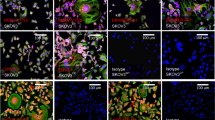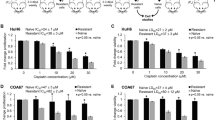Abstract
We evaluated the molecular mechanism of resistance in herpes simplex virus type 1 (HSV-1) thymidine kinase (TK) gene-transfected murine mammary carcinoma (FM3ATK−/HSV-1 TK+) cells, that were selected for resistance against (E)-5-(2-bromovinyl)-2′-deoxyuridine (BVDU) and ganciclovir (GCV) by prolonged exposure of the cell cultures to dose-escalating concentrations of these compounds. Drug-resistant FM3ATK−/HSV-1 TK+ cells showed marked differences in their sensitivity spectrum to a series of antiherpetic nucleoside analogues. BVDU-resistant FM3ATK−/HSV-1 TK+ cells displayed the same sensitivity profile as wild-type FM3A/0 cells. In contrast, GCV-resistant FM3ATK−/HSV-1 TK+ cells were still sensitive to BVDU, (E)-5-(2-iodovinyl)-2′-deoxyuridine (IVDU) and (E)-5-(2-bromovinyl)-2′-deoxycytidine (BVDC), a typical feature of FM3ATK− cells lacking cytosolic TK. Southern blot and PCR analysis revealed that HSV-1 TK genes were not deleted from the genome of the drug-resistant FM3ATK−/HSV-1 TK+cells. However, the TK genes in drug-resistant FM3ATK−/HSV-1 TK+cells were shown to be heavily methylated. Accordingly, RT-PCR demonstrated the complete abrogation of TK mRNA production resulting in a complete loss of TK enzyme activity in drug-resistant FM3ATK−/HSV-1 TK+ cells.
This is a preview of subscription content, access via your institution
Access options
Subscribe to this journal
Receive 12 print issues and online access
$259.00 per year
only $21.58 per issue
Buy this article
- Purchase on Springer Link
- Instant access to full article PDF
Prices may be subject to local taxes which are calculated during checkout








Similar content being viewed by others
References
De Clercq E . Antivirals for the treatment of herpesvirus infections J Antimicrob Chemo 1993 32: 121–132
Balzarini J, De Clercq E, Ayusawa D, Seno T . Murine mammary FM3A carcinoma cells transformed with the herpes simplex virus type 1 thymidine kinase gene are highly sensitive to the growth-inhibitory properties of (E)-5-(2-bromovinyl)-2′-deoxyuridine and related compounds FEBS Lett 1985 185: 95–100
Balzarini J et al. Highly selective cytostatic activity of (E)-5-(2-bromovinyl)-2′-deoxyuridine derivatives for murine mammary (FM3A) carcinoma cells transformed with the herpes simplex virus type 1 thymidine kinase gene Mol Pharmacol 1985 28: 581–587
Balzarini J, Bohman C, De Clercq E . Differential mechanism of cytostatic effect of (E)-5-(2-bromovinyl)-2′-deoxyuridine, 9-(1,3-dihydroxy-2-propoxymethyl)guanine, and other antiherpetic drugs on tumor cells transfected by the thymidine kinase gene of herpes simplex virus type 1 or type 2 J Biol Chem 1993 268: 6332–6337
Balzarini J, Bohman C, Walker RT, De Clercq E . Comparative cytostatic activity of different antiherpetic drugs against herpes simplex virus thymidine kinase gene-transfected tumor cells Mol Pharmacol 1994 45: 1253–1258
Culver KW et al. In vivo gene transfer with retroviral vector-producer cells for treatment of experimental brain tumors Science 1992 256: 1550–1552
Ram Z et al. Therapy of malignant brain tumors by intratumoral implantation of retroviral vector-producing cells Nature Med 1997 3: 1354–1361
Ayusawa D et al. Establishment of mutant FM3A murine mammary carcinoma cell lines transformed with the herpes simplex virus type 1 thymidine kinase gene Jpn J Cancer Res 1985 76: 984–988
Balzarini J et al. Increased sensitivity of thymidine kinase-deficient (TK−) tumor cell lines to the cell growth inhibitory effects of (E)-5-(2-bromovinyl)-2′-deoxyuridine (BVDU) and related compounds Anticancer Res 1986 6: 1077–1084
Nakano N . Establishment of cell lines in vitro from a mammary ascites tumor of mouse and biological properties of the established lines in a serum containing medium Tohoku J Exp Med 1966 88: 69–84
Balzarini J . Herpes simplex virus thymidine kinase gene-transfected tumor cells: sensitivity to antiherpetic drugs Nucleosides Nucleotides 1996 15: 821–831
Clough DW, Kunkel LM, Davidson RL . 5-Azacytidine-induced reactivation of a herpes simplex thymidine kinase gene Science 1982 216: 70–73
Tasseron-de Jong JG, den Dulk H, van de Putte P, Giphart-Gassler M . De novo methylation as major event in the inactivation of transfected herpesvirus thymidine kinase genes in human cells Biochim Biophys Acta 1989 1007: 215–223
Moolten FL, Wells JM, Heyman RA, Evans RM . Lymphoma regression induced by ganciclovir in mice bearing a herpes thymidine kinase transgene Hum Gene Ther 1990 1: 125–134
Moolten FS, Wells JM, Mroz PJ . Multiple transduction as a means of preserving ganciclovir chemosensitivity in sarcoma cells carrying retrovirally transduced herpes thymidine kinase genes Cancer Lett 1992 64: 257–263
Yang L et al. Mechanisms for ganciclovir resistance in gastrointestinal tumor cells transduced with a retroviral vector containing the herpes simplex virus thymidine kinase gene Clin Cancer Res 1998 4: 731–741
Golumbek PT et al. Herpes simplex-1 virus thymidine kinase gene is unable to completely eliminate live, nonimmunogenic tumor cell vaccines J Immunother 1992 12: 224–230
Balzarini J et al. 5-Substituted 2′-deoxyuridines: correlation between inhibition of tumor cell growth and inhibition of thymidine kinase and thymidylate synthetase Biochem Pharmacol 1982 31: 3673–3682
Bubley G, Crumpacker C, De Clercq E, Schnipper L . Effects of (E)-5-(2-bromovinyl)-2′-deoxyuridine on the proliferation of herpes simplex virus type 1-transformed and thymidine kinase-deficient mouse cells Virology 1983 129: 490–492
Degrève B et al. Varicella-zoster virus thymidine kinase gene and antiherpetic pyrimidine nucleoside analogues in a combined gene/chemotherapy treatment for cancer Gene Therapy 1997 4: 1107–1114
Moolten FL, Wells JM . Curability of tumors bearing herpes thymidine kinase genes transferred by retroviral vectors J Natl Cancer Inst 1990 82: 297–300
Degrève B, De Clercq E, Balzarini J . Bystander effect of purine nucleoside analogues in HSV-1 tk suicide gene therapy is superior to that of pyrimidine nucleoside analogues Gene Therapy 1999 6: 162–170
Bi WL, Parysek LM, Warnick R, Stambrook PJ . In vitro evidence that metabolic cooperation is responsible for the bystander effect observed with HSV tk retroviral gene therapy Hum Gene Ther 1993 4: 725–731
Ishii-Morita H et al. Mechanism of ‘bystander effect′ killing in the herpes simplex thymidine kinase gene therapy model of cancer treatment Gene Therapy 1997 4: 244–251
Braakman E et al. Ganciclovir-mediated in vivo elimination of myeloid leukemic cells expressing the HSVtk gene induces HSVtk loss variants Gene Therapy 1999 6: 1139–1146
Barba D, Hardin J, Ray J, Gage FH . Thymidine kinase-mediated killing of rat brain tumors J Neurosurg 1993 79: 729–735
Degrève B et al. Differential intracellular compartmentalization of herpetic thymidine kinases (TKs) in TK gene-transfected tumor cells: molecular characterization of the nuclear localization signal of herpes simplex virus type 1 TK J Virol 1998 72: 9535–9543
Ives DH, Wang SM . Deoxycytidine kinase from calf thymus Meth Enzymol 1978 51: 337–345
Acknowledgements
We thank Christiane Callebaut and Inge Aerts for dedicated editorial help and Lizette van Berckelaer for excellent technical help. This work was supported by Project G0140–98 from the Flemish ‘Fonds Voor Wetenschappelijk Onderzoek’, Project 00/12 from the Flemish ‘Geconcerteerde Onderzoeksacties’, and the ‘Belgische Federatie tegen kanker’. Bart Degrève is the recipient of a fellowship from the ‘Belgische Federatie tegen kanker’.
Author information
Authors and Affiliations
Rights and permissions
About this article
Cite this article
Degrève, B., De Clercq, E. & Balzarini, J. Selection of HSV-1 TK gene-transfected murine mammary carcinoma cells resistant to (E)-5-(2-bromovinyl)-2′-deoxyuridine (BVDU) and ganciclovir (GCV). Gene Ther 7, 1543–1552 (2000). https://doi.org/10.1038/sj.gt.3301278
Received:
Accepted:
Published:
Issue Date:
DOI: https://doi.org/10.1038/sj.gt.3301278



